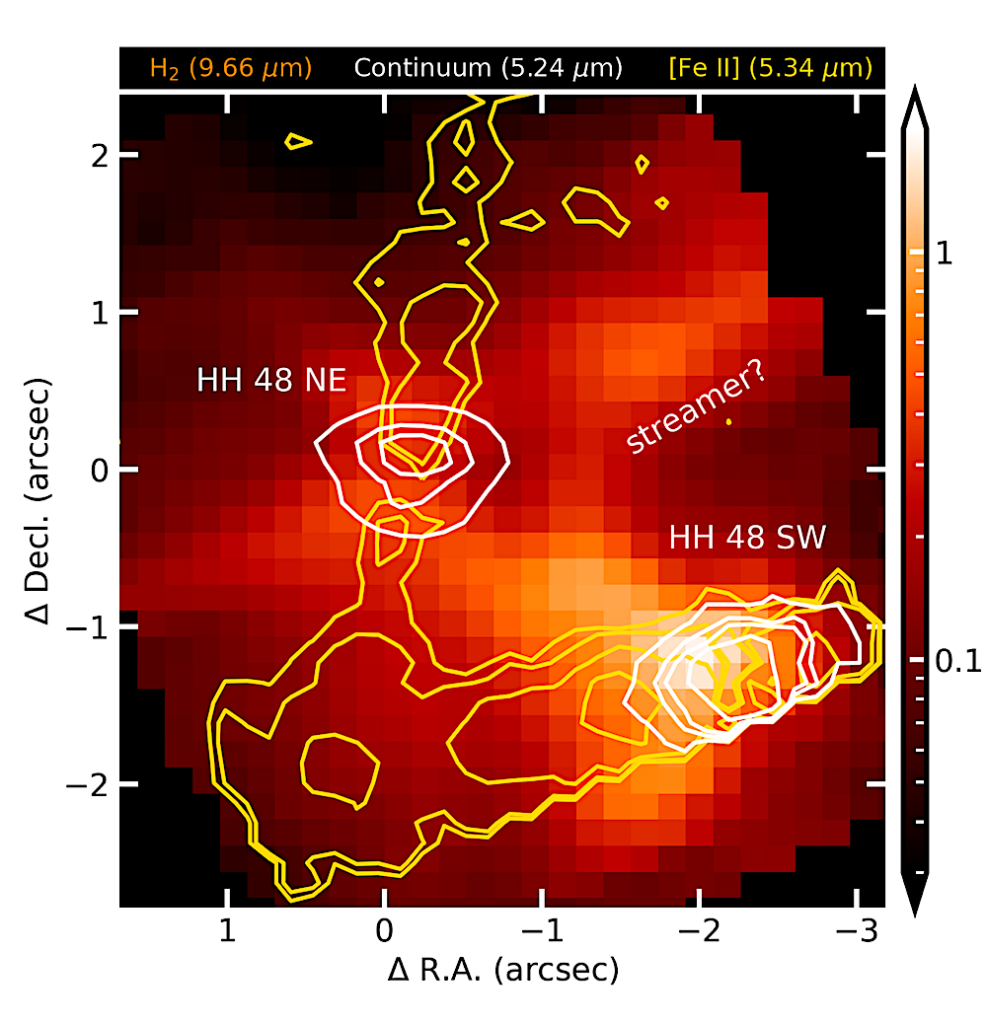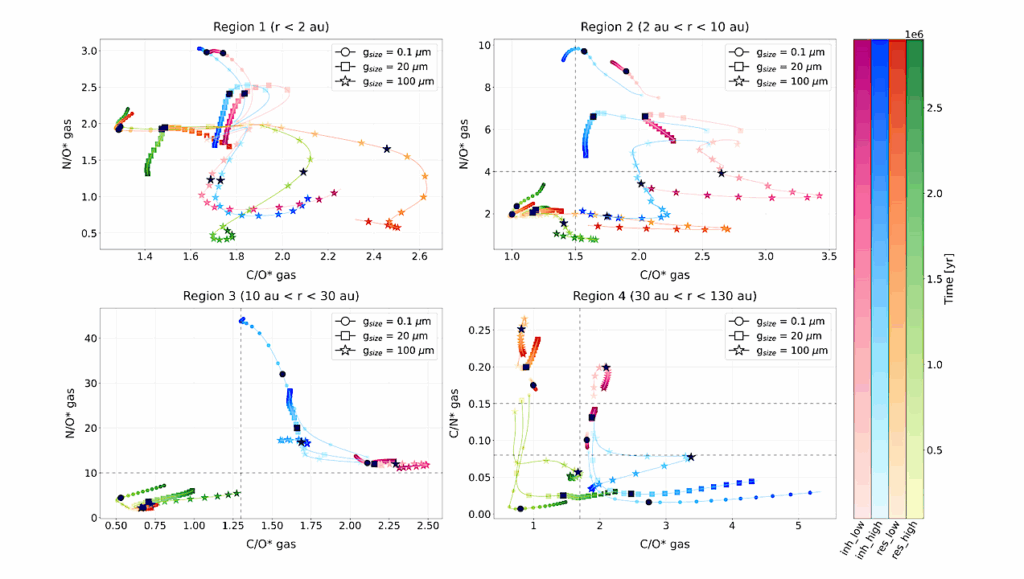A JWST/MIRI Aanalysis Of The Ice Distribution And PAH Emission In The Protoplanetary Disk HH 48 NE

Ice-coated dust grains provide the main reservoir of volatiles that play an important role in planet formation processes and may become incorporated into planetary atmospheres.
However, due to observational challenges, the ice abundance distribution in protoplanetary disks is not well constrained. We present JWST/MIRI observations of the edge-on disk HH 48 NE carried out as part of the IRS program Ice Age.
We detect CO2, NH3, H2O and tentatively CH4 and NH+4. Radiative transfer models suggest that ice absorption features are produced predominantly in the 50-100 au region of the disk. The CO2 feature at 15 micron probes a region closer to the midplane (z/r = 0.1-0.15) than the corresponding feature at 4.3 micron (z/r = 0.2-0.6), but all observations trace regions significantly above the midplane reservoirs where we expect the bulk of the ice mass to be located.

Overview of the HH 48 system at MIRI wavelengths. The continuum subtracted H2 V = 0 − 0, J = 5 − 3 line emission (9.66 µm) is shown in color tracing a complex structure of outflows and potential infall. The continuum at 5.24 µm is shown in white contours at 20, 60, 100, and 300 µJy, tracing the scattered light from the two protoplanetary disks. The [Fe II] line at 5.34 µm is shown in the yellow contours at 5, 10, 30, and 100 µJy tracing the jets of both protostars. The primary, HH 48 SW and secondary, HH 48 NE are labeled in white. — astro-ph.EP
Ices must reach a high scale height (z/r ~ 0.6; corresponding to modeled dust extinction Av ~ 0.1), in order to be consistent with the observed vertical distribution of the peak ice optical depths. The weakness of the CO2 feature at 15 micron relative to the 4.3 micron feature and the red emission wing of the 4.3 micron CO2 feature are both consistent with ices being located at high elevation in the disk.
The retrieved NH3 abundance and the upper limit on the CH3OH abundance relative to H2O are significantly lower than those in the interstellar medium (ISM), but consistent with cometary observations. Full wavelength coverage is required to properly study the abundance distribution of ices in disks. To explain the presence of ices at high disk altitudes, we propose two possible scenarios: a disk wind that entrains sufficient amounts of dust, thus blocking part of the stellar UV radiation, or vertical mixing that cycles enough ices into the upper disk layers to balance ice photodesorption.

First column from the left: The spatial appearance of the continuum emission from HH 48 NE in the optical HST observations, JWST MIRI observations, and millimeter ALMA continuum observations. Second and third columns: spatial appearance of the continuum emission from the fiducial model and MIRI fit, respectively, after convolution to a representative PSF. Last two columns: median averaged vertical and radial profile of the continuum emission normalized to the peak (black) with the fiducial model (orange) and MIRI fit (blue) on top. The orange box marks the region where HH 48 SW starts dominating the continuum. — astro-ph.EP
J. A. Sturm, M. K. McClure, D. Harsono, J. B. Bergner, E. Dartois, A. C. A. Boogert, M. A. Cordiner, M. N. Drozdovskaya, S. Ioppolo, C. J. Law, D. C. Lis, B. A. McGuire, G. J. Melnick, J. A. Noble, K. I. Öberg, M. E. Palumbo, Y. J. Pendleton, G. Perotti, W. R. M. Rocha, R. G. Urso, E. F. van Dishoeck
Comments: 16 pages, 11 figures, accepted in A&A
Subjects: Earth and Planetary Astrophysics (astro-ph.EP)
Cite as: arXiv:2407.09627 [astro-ph.EP] (or arXiv:2407.09627v1 [astro-ph.EP] for this version)
https://doi.org/10.48550/arXiv.2407.09627
Focus to learn more
Submission history
From: Ardjan Sturm
[v1] Fri, 12 Jul 2024 18:29:38 UTC (5,095 KB)
https://arxiv.org/abs/2407.09627
Astrobiology, Astrochemistry,








